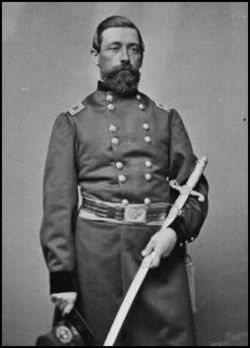James Nagle (general) facts for kids
Quick facts for kids
James Nagle
|
|
|---|---|

James Nagle
|
|
| Born | April 5, 1822 Reading, Pennsylvania |
| Died | August 22, 1866 (aged 44) Pottsville, Pennsylvania |
| Place of burial |
Presbyterian Cemetery, Pottsville, Pennsylvania
|
| Allegiance | United States of America Union |
| Service/ |
United States Army Union Army |
| Years of service | 1846–1848; 1861–1864 |
| Rank | |
| Unit | Army of the Potomac |
| Commands held | 1st Brigade, 2nd Division, IX Corps 48th Pennsylvania Volunteer Infantry Regiment |
| Battles/wars | |
| Other work | painter, paper hanger, sheriff |
James Nagle (born April 5, 1822 – died August 22, 1866) was an important officer in the United States Army. He fought in two major wars: the Mexican–American War and the American Civil War. During the Civil War, he gathered and led many soldiers from Pennsylvania. He commanded different groups of soldiers called brigades. James Nagle is famous for his actions at the 1862 Battle of Antietam. His soldiers helped capture a key crossing called Burnside's Bridge during this battle.
Contents
Early Life and First Military Service
James Nagle was born in Reading, Pennsylvania. He was the oldest of eight children. His family moved several times, finally settling in Pottsville, Pennsylvania in 1835. There, in 1842, he helped start a group called the Washington Artillery Company. He also learned how to be a painter and paperhanger from his father.
When the Mexican–American War began, James Nagle and his men joined the army. They became Company B of the 1st Pennsylvania Volunteers. His group was stationed at Perote Castle. They helped keep communication lines open to Veracruz. Nagle fought in several battles, including Huamantla and Puebla. He also entered Mexico City. After the war ended, he left the army in 1848. The people of Schuylkill County, Pennsylvania gave him a special sword to honor his service.
Life Before the Civil War
After the war, Nagle went back to being a painter and paperhanger. In 1852, he was elected as the sheriff of Schuylkill County. He held this job until the Civil War started in 1861. Also in 1852, Nagle married Elizabeth Kaercher. They had nine children together. He was also involved in his community. He served on the Pottsville School Board and was president of the borough council.
Civil War Service and Key Battles
When the American Civil War began in 1861, James Nagle quickly joined the Union Army. He became the colonel of the 6th Pennsylvania Infantry. This group served for three months. After their service ended, Nagle formed a new group. This was the 48th Pennsylvania Volunteer Infantry Regiment. He became its colonel. Many of his old friends from the Washington Artillery joined him. Four of his brothers also served in this regiment.
Nagle's regiment first served in Virginia and North Carolina. In April 1862, he was given command of the 1st Brigade. This group was part of Maj. Gen. Jesse Reno's division.
Fighting at Second Bull Run and Antietam
Nagle led his brigade in the Second Battle of Bull Run. This was a major battle in Virginia. On September 10, 1862, he was promoted to brigadier general. This was a very important rank.
Just a few days later, Nagle's brigade played a huge role at the Battle of Antietam. This battle was fought in Maryland. His soldiers helped capture Burnside's Bridge. This bridge was a key crossing over Antietam Creek. Capturing the bridge was very important for the Union Army. The army commander, George B. McClellan, said Nagle's actions "saved the day."
Later Service and Health Issues
Nagle's health began to get worse. He suffered from heart disease. Because of his health, he resigned from the army in May 1863. He went home to recover.
However, when General Robert E. Lee invaded Pennsylvania in June 1863, Nagle returned to duty. He quickly organized a new group of soldiers. This was the 39th Pennsylvania Volunteer Militia. He became its colonel. He commanded these emergency soldiers. They were mustered out of service after the Gettysburg Campaign ended. Lee's army retreated back into Virginia.
In 1864, Nagle organized another group of soldiers. This was the 149th Pennsylvania Infantry. They served for 100 days. They guarded the areas around Baltimore, Maryland. After their service ended, Nagle left the army for good.
Life After the War
After the Civil War, James Nagle returned to his civilian life. However, his health continued to be poor. He suffered from heart and liver problems. He died in 1866 at his home in Pottsville. He was surrounded by his family. His funeral was well attended. He was buried in Pottsville's Presbyterian Cemetery.
Today, James Nagle is honored with a statue. It is on the 48th Pennsylvania's monument. This monument is located on the Antietam National Battlefield in Maryland.
Images for kids


